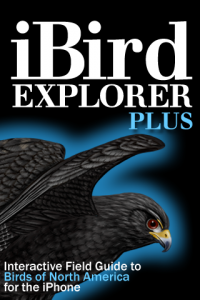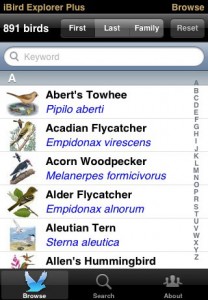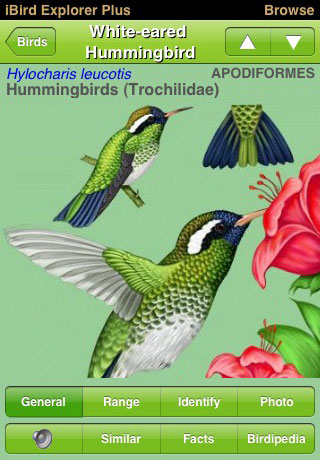iBird Explorer Plus
 Since the iPhone came out I wondered how long it would take for someone to come out with some good birding apps. Longer than I had expected, it turns out. A few small apps with limited usefulness appeared early on but none had the two main rings I was looking for: a mini field guide and a checklist. Then one day I came across something new, and very promising: the iBird Explorer Plus software.
Since the iPhone came out I wondered how long it would take for someone to come out with some good birding apps. Longer than I had expected, it turns out. A few small apps with limited usefulness appeared early on but none had the two main rings I was looking for: a mini field guide and a checklist. Then one day I came across something new, and very promising: the iBird Explorer Plus software.
iBird Explorer Basics
When I bought this, it was only for the Apple iPhone, downloadable directly from the iTunes store. There is a Windows Mobile version (“Winged Explorer”), but obviously, having an iPhone, I can’t tell you a lot about that version and so my review is of the iPhone version only. If you visit the iBird Explorer website, you’ll see that there are 6 variants of the program with a variety of specs and costs. Essentially, there are 3 main programs: iBird Backyard ($4.99), iBird Regional ($9.99) and iBird Plus ($19.99).
- iBird Backyard covers about 150 species of common backyard birds found throughout the country.
- iBird Regional is actually 5 separate versions related to geographic areas: iBird North (the northeast U.S.), iBird South, iBird Midwest, iBird West and iBird Canada
- iBird Explorer Plus– this is the biggie, which covers all species which can be found in the U.S. including references for some extinct species (you never know when that Eskimo Curlew will show up again!).
The applications are remarkably similar with the main difference being the obvious scope of the birds being covered. I went with the $19.99 Plus version simply because we were already planning a trip to Arizona, so I knew that it would come in handy. It’s the most expensive app I’ve ever bought there, but so far has been worth every penny.
Main Controls
Browse
 The first time I used this app, I was immediately impressed. The diversity of options and tools is very impressive. When you first start it you are on the BROWSE section, presented as a list of birds sorted alphabetically, each with a thumbnail drawing of the species. You can them sort by ‘first’ name (red-breasted…) or ‘last’ name (merganser) or family (which includes silhouettes odd the birds to help).
The first time I used this app, I was immediately impressed. The diversity of options and tools is very impressive. When you first start it you are on the BROWSE section, presented as a list of birds sorted alphabetically, each with a thumbnail drawing of the species. You can them sort by ‘first’ name (red-breasted…) or ‘last’ name (merganser) or family (which includes silhouettes odd the birds to help).
Search
If you prefer to search instead of browsing, you can use the application’s great filter system. It allows you to create any number of filters to get a shorter list of choices, displayed as a list of birds in a similar fashion as the browse section. The filters that you can choose from:
- Location (state or territory)
- Shape (duck like, owl like, etc.)
- Size (extra- small to extra large)
- Habitat (ocean, prairie, etc.)
- Color Primary
- Color Secondary
- Backyard Feeder (uncommon or frequent)
- Family (same as the main page)
- Bill Shape (all purpose, cone, hooked, etc.)
- Bill Length (same, longer or shorter than head)
- Head Pattern (capped, eyeline, masked, etc.)
- Crown Color
- Wing Shape (broad-wings, pointed-wings, etc.)
- Flight Pattern (direct, flap and glide, mothlike, etc.)
Bird Entry
Selecting a bird gives you the mother lode of information – in fact, it’s pretty amazing how much info they can pack into this application.
Bird
The initial tab is the basic info on the bird. Of course you see the common name, the scientific name, the family and the order, add well as a nice illustration of the bird. Below the illustration comes a basic description that summarizes information found on other tabs in a singel spot. On some birds, there is a number on the tab, which indicates additional illustrations, usually for gender and alternate plumages – breeding and non-breeding plumage, eclipse plumage, etc.
Range
Thus shows the birds range on the map, showing summer, winter and year round ranges, limited to the half of the country its more likely to be seen (ie western or eastern US). A brief summary of the migration habits of the bird are also included.
Identify
This is the section that has the meat of the information for the application. It has a wide variety of data and info to help a birder know about the species, each in it’s own ‘box’ of content. The rundown of data:
Body – length, weigh, size, color, feather patterns, etc.
Head – eye color, head pattern, crown color, throat color, etc.
Flight – pattern, wingspan, wing and tail shapes, colors to look for, etc.
General – a general description of the bird, including both male and female key field marks.
Range & Habitat – brief description.
Breeding & Nesting – description of the nest, including a summary of the items marked (*) below.
Foraging & Feeding, Readily Eats – both of these sections talk about the feeding habits of the bird.
Vocalization – phonetic description of the songs
Similar Species – a short list of similar species (although no description of differentiating factors).
Breeding Location – habitat for breeding and nesting
Breeding Type – monogamy or polygamy, nesting in groups or solitarily, etc.
Egg Color*, Number of Eggs*, Incubation Days*, Egg Incubator* (male, female or shared), Nest Material* – these sections seem a little redundant to the Breeding & Nesting section above, to be honest.
Migration – migratory or not.
Photos
Many species include a number of photographs, noted on the tab by a number. The photos I’ve looked at seem to be of very good quality, and since they offer a chance to submit your own photographs to the site, I’m sure that the quality will continue to impress.
Sound
One of the top aspects of this software its the inclusion of the songs of most birds, playable right on the iPhone. Opening the ‘Sound’ tab (indicated by a speaker icon) immediately starts playing the song of that bird. Many times, the bird selected is one of several ‘Similar Species’ that is included so that you can compare songs of similar birds. Below the actual songs is the phonetic description of the songs. So far, I’ve really enjoyed the songs, which range from 5s to about 30s in length. The only disadvantage is for birds with more extensive repertoires, which can’t be fully included on this application. And you can’t get to particular sections of songs – you can only start at the beginning of the song, although you can stop it at any time.
Similar
This tab is particularly helpful, since it lists all of the similar species in a list, allowing you a quick method to bring up THEIR information.
Facts
This section is more fun than truly functional, giving a number of facts and additional pieces of information about the species.
Birdapedia
Birdapedia brings up a Wikipedia-like description of the species which includes links to further resources on the web.
Favorites
New in version 1.5 (the latest update), this section allows you to save a favorite set of birds for quick access. This list can then be sorted, updated, etc. [note: this needs to be enabled from the iPhone’s ‘Settings’ button].
Flickr
Also, new in version 1.5, this allows you to access pictures of the species on Flickr. [note: this needs to be enabled from the iPhone’s ‘Settings’ button].
With all of these controls, you can move forward and backward through the list from your current bird using the arrow controls at the top fo the application.
Help
General help with the application, including tools, FAQs and even a tutorial movie.
Glossary
A pretty extensive glossary of bird anatomical terms.
More…
A short description from the writer, and a Twitter feed.
What’s Missing?
There are only a couple of things missing from this application. One is that I wish the songs were a little more extensive — perhaps include different songs for a single species instead of a single, longer sequence of songs (for example, a breeding call vs. a call note). But the other great addition – which is supposedly in the works – is the ability to have a sighting checklist so that you can track while out in the field. They are talking about having it connect directly to eBird, which wold be very cool, but I would be satisfied with it simply being able to tick off species or better yet, allow you to tabulate numbers (such as having a “+” symbol to add to the number of a particular species).
Other than that, I have to say that this is a pretty great application.
All images in this review borrowed from AppBeacon (http://appbeacon.com/apps/010702/ibird-explorer-plus).

pretty robust lil’ app there! i wonder if they will come out with something new when 3.0 comes out to leverage some of the new (well, omitted) features
I don’t know – the new Flickr and favorites thing is pretty cool. But I’m hearing that several of the new features will NOT be supported by iPhone 1.0, so I won’t be able to use ’em anyway.
Hmm, I have a blackberry but this is something that might talk me into an Ipod! I do have service from ATT!
Tom – they have a Windows Mobile version, too, called “Winged Explorer”.
I just downloaded my stokes cd’s into mp3’s and play them that way! But this is for sure interesting!